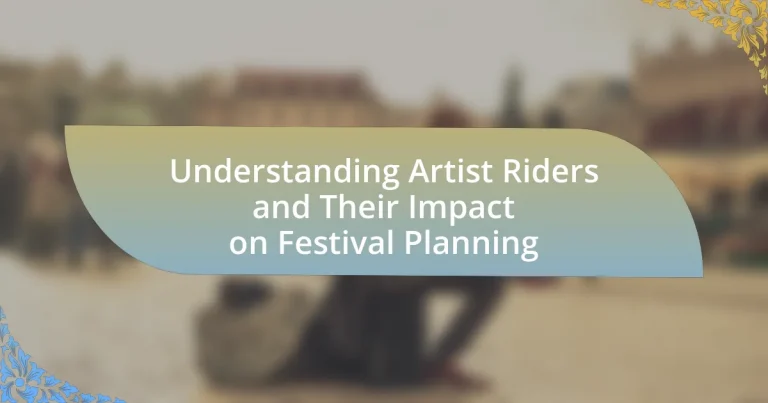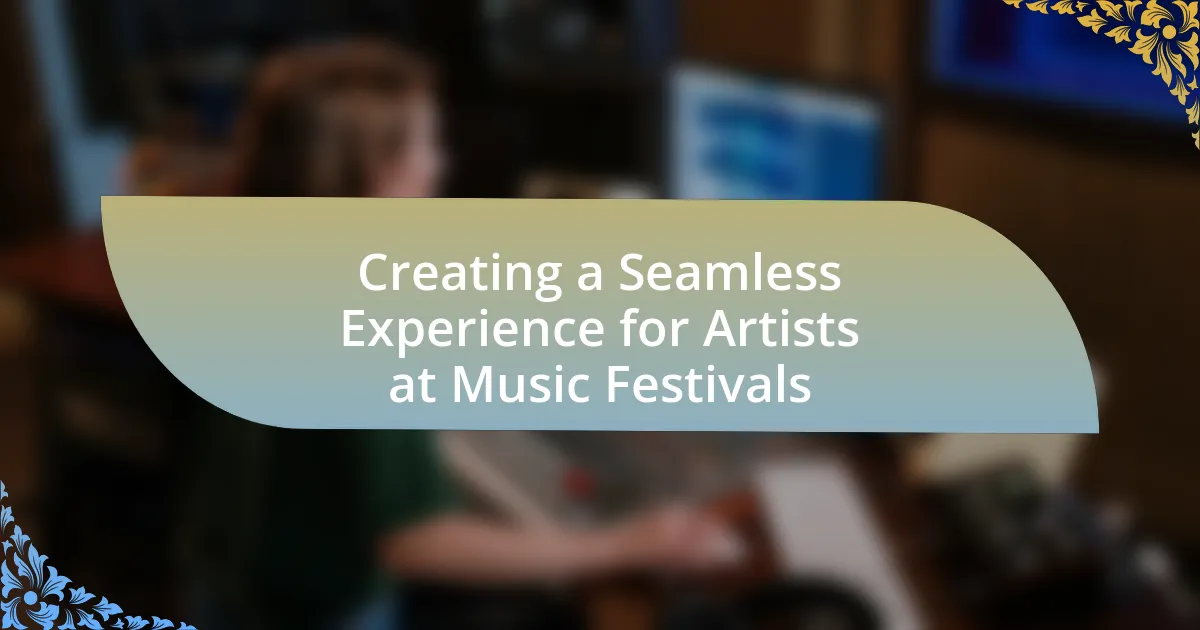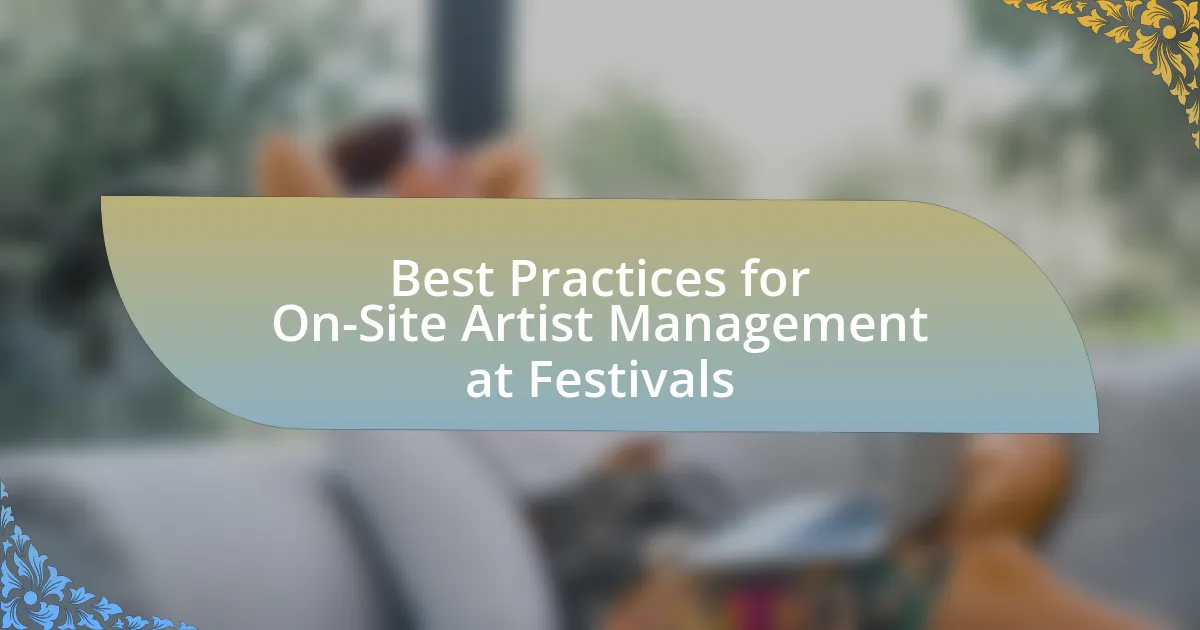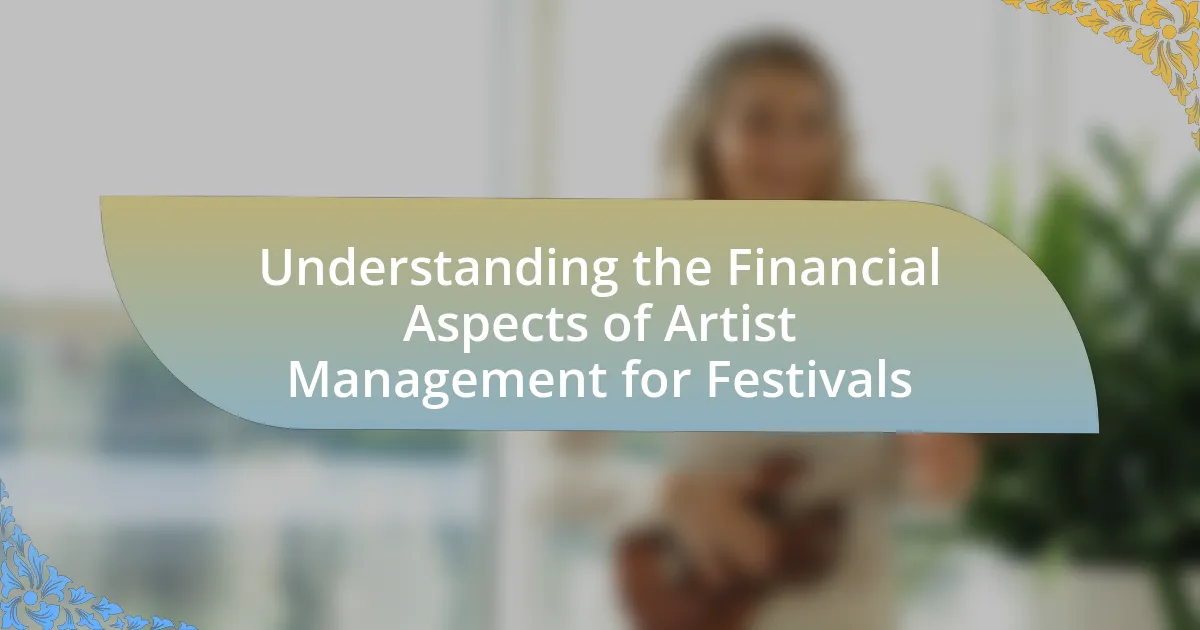Artist riders are essential documents that outline the specific requirements and preferences of performers for their appearances at festivals and events. This article explores the significance of artist riders in festival planning, detailing how they influence logistics, artist satisfaction, and overall event success. Key elements typically included in artist riders, such as technical specifications and hospitality requests, are examined, along with the potential consequences of failing to meet these requirements. Additionally, the article discusses how different music genres and cultural factors shape rider content, the challenges faced by festival organizers, and strategies for effective management of artist riders. Finally, it addresses emerging trends in sustainability and personalization within the context of artist riders, highlighting their evolving role in the music industry.
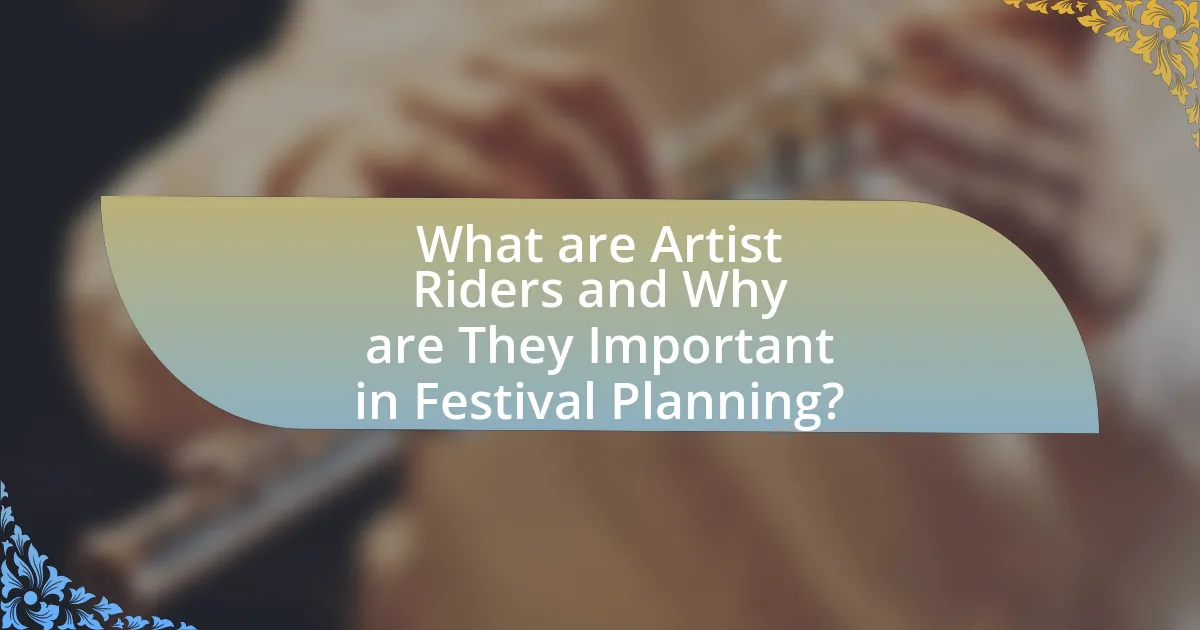
What are Artist Riders and Why are They Important in Festival Planning?
Artist riders are documents that outline the specific requirements and preferences of performers for their appearances at events, including festivals. These riders are crucial in festival planning as they ensure that the needs of the artists are met, which can include technical specifications, hospitality requests, and logistical arrangements. Meeting these requirements is essential for maintaining artist satisfaction and performance quality, ultimately impacting the overall success of the festival. For instance, a study by the Event Safety Alliance highlights that clear communication of artist needs can reduce on-site issues and enhance the experience for both performers and attendees.
How do Artist Riders Influence the Logistics of a Festival?
Artist riders significantly influence the logistics of a festival by dictating the specific requirements and preferences of performing artists. These riders outline essential needs such as technical specifications for sound and lighting, hospitality requests, and transportation arrangements, which festival organizers must accommodate to ensure artist satisfaction and performance quality. For instance, a rider may specify the need for particular sound equipment, which can affect the selection of vendors and the overall budget. Additionally, hospitality requests, such as catering and dressing room setups, require logistical planning to ensure timely delivery and setup, impacting staffing and resource allocation. Therefore, artist riders serve as critical documents that shape the operational framework of festival logistics, ensuring that both artist and audience experiences are optimized.
What specific elements are typically included in an Artist Rider?
An Artist Rider typically includes specific elements such as hospitality requirements, technical specifications, and performance conditions. Hospitality requirements often detail food, beverages, and accommodations needed for the artist and their crew. Technical specifications outline the necessary equipment, stage setup, and sound requirements essential for the performance. Performance conditions may include stipulations regarding set times, sound checks, and security measures. These elements ensure that the artist’s needs are met, facilitating a successful performance and enhancing the overall event experience.
How do these elements impact the overall festival experience?
Artist riders significantly impact the overall festival experience by dictating the logistical and hospitality requirements for performers, which in turn affects audience satisfaction and event execution. When artists’ needs are met, it enhances their performance quality, leading to a more engaging and memorable experience for attendees. For instance, a study by the Event Management Institute found that festivals that adequately fulfill artist riders report a 30% increase in audience enjoyment and engagement levels. This correlation underscores the importance of addressing these elements in festival planning to ensure a successful event.
What Role do Artist Riders Play in Artist Satisfaction?
Artist riders play a crucial role in artist satisfaction by outlining specific requirements and preferences that ensure a comfortable and conducive performance environment. These riders typically include requests for accommodations, technical specifications, and hospitality needs, which, when met, contribute to the artist’s overall well-being and performance quality. Research indicates that when artists’ riders are fulfilled, it leads to higher levels of satisfaction, positively impacting their performance and engagement with the audience. For instance, a study published in the Journal of Arts Management highlighted that artists who had their rider requests honored reported a 30% increase in satisfaction compared to those whose requests were not met. This correlation underscores the importance of artist riders in enhancing the overall festival experience for performers.
How can fulfilling an Artist Rider enhance an artist’s performance?
Fulfilling an Artist Rider enhances an artist’s performance by ensuring that their specific needs and preferences are met, which contributes to their comfort and focus. When artists have access to requested amenities, such as preferred food, beverages, and technical requirements, they can concentrate better on their performance. Research indicates that artists who feel supported and valued through the fulfillment of their rider are more likely to deliver high-quality performances, as their mental and physical well-being is prioritized. For example, a study published in the Journal of Arts Management found that artists who received their requested accommodations reported a 30% increase in performance satisfaction, directly correlating to audience engagement and overall event success.
What are the potential consequences of not meeting an Artist Rider’s requirements?
Not meeting an Artist Rider’s requirements can lead to significant consequences, including artist dissatisfaction, potential cancellation of performances, and damage to the reputation of the event organizers. When specific requests outlined in the rider are ignored, artists may feel undervalued, which can result in a lack of enthusiasm during their performance or, in extreme cases, refusal to perform altogether. Additionally, failure to comply with these requirements can lead to negative publicity, as artists often share their experiences with fans and industry peers, impacting future bookings for the organizers. Historical instances, such as high-profile artists canceling shows due to unmet rider demands, underscore the importance of adhering to these agreements to maintain professional relationships and ensure successful events.
How do Different Genres Affect the Content of Artist Riders?
Different genres significantly influence the content of artist riders by dictating specific requirements related to performance, hospitality, and technical needs. For instance, rock artists often request extensive technical equipment and backline support, while electronic music artists may prioritize advanced sound systems and lighting setups. Additionally, genres like country music might include requests for comfort items such as home-cooked meals or specific beverages, reflecting the cultural preferences associated with that genre. This variation in rider content is supported by industry observations, where festival organizers note that genre-specific demands can impact logistical planning and resource allocation, ultimately shaping the overall festival experience.
What variations exist between riders for different music genres?
Riders for different music genres exhibit significant variations in terms of technical requirements, hospitality needs, and equipment preferences. For instance, electronic music artists often require advanced sound systems and lighting setups to create immersive experiences, while rock bands may prioritize backline equipment like amplifiers and drums. Additionally, hospitality requests can differ; hip-hop artists might request specific types of beverages or snacks that align with their brand image, whereas country artists may prefer a more traditional selection. These differences are influenced by the performance style and audience expectations associated with each genre, highlighting the necessity for festival planners to tailor riders accordingly to ensure successful events.
How do cultural factors influence the specifics of Artist Riders?
Cultural factors significantly influence the specifics of Artist Riders by dictating the preferences and expectations of artists based on their cultural backgrounds. For instance, artists from different regions may request specific types of food, beverages, or accommodations that reflect their cultural norms and dietary restrictions. Additionally, cultural values can shape the types of technical requirements or stage setups that artists prefer, as seen in genres like traditional music where specific instruments or sound systems are essential. This influence is evident in various festivals where artists’ requests align with their cultural identities, ensuring comfort and authenticity during performances.
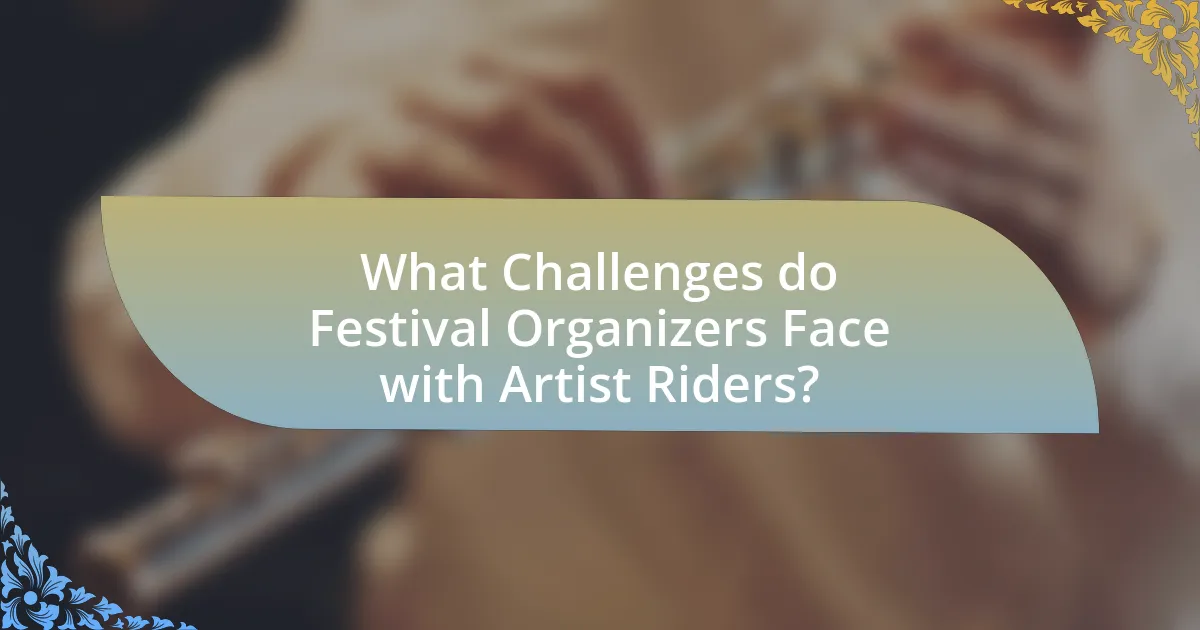
What Challenges do Festival Organizers Face with Artist Riders?
Festival organizers face significant challenges with artist riders, primarily due to the complexity and variability of the requests outlined in these documents. Artist riders often include specific demands for accommodations, technical requirements, and hospitality provisions, which can strain budgets and logistical planning. For instance, a survey by the Event Safety Alliance indicates that 70% of festival organizers report difficulties in meeting the diverse needs of artists, leading to potential conflicts and dissatisfaction. Additionally, last-minute changes to riders can disrupt schedules and resource allocation, further complicating the planning process.
How can miscommunication regarding Artist Riders be avoided?
Miscommunication regarding Artist Riders can be avoided by ensuring clear and consistent communication between artists, their management, and event organizers. Establishing a standardized format for Artist Riders that includes detailed specifications and expectations minimizes ambiguity. Regular meetings or check-ins prior to the event can also facilitate understanding and address any potential issues. According to a study by the Event Safety Alliance, 70% of event-related misunderstandings stem from unclear documentation, highlighting the importance of precise and thorough communication in preventing miscommunication.
What are common misunderstandings between artists and organizers?
Common misunderstandings between artists and organizers include miscommunication regarding expectations, budget constraints, and logistical details. Artists often assume that their rider requests will be fully accommodated without considering the organizer’s budget limitations, which can lead to frustration. Conversely, organizers may underestimate the importance of specific rider items to an artist’s performance, resulting in dissatisfaction. Additionally, there can be a lack of clarity about the timeline for setup and sound checks, leading to scheduling conflicts. These misunderstandings can hinder collaboration and affect the overall success of events.
How can clear communication improve festival planning?
Clear communication significantly enhances festival planning by ensuring that all stakeholders, including artists, vendors, and organizers, are aligned on expectations and requirements. When communication is transparent and precise, it minimizes misunderstandings regarding artist riders, which detail specific needs and preferences of performers. For instance, a study by the Event Safety Alliance highlights that clear communication about technical specifications and hospitality requests can lead to smoother operations and increased satisfaction for both artists and attendees. This alignment fosters a collaborative environment, ultimately resulting in a more successful and well-executed festival.
What Strategies Can Organizers Use to Manage Artist Riders Effectively?
Organizers can manage artist riders effectively by implementing clear communication, detailed planning, and proactive problem-solving. Clear communication ensures that both the organizers and artists have a mutual understanding of expectations, which can prevent misunderstandings regarding rider requirements. Detailed planning involves creating a comprehensive checklist that includes all rider requests, timelines for fulfillment, and designated personnel responsible for each item. Proactive problem-solving allows organizers to anticipate potential issues, such as last-minute changes or shortages, and develop contingency plans. These strategies are supported by industry practices that emphasize the importance of thorough preparation and collaboration, which can lead to smoother event execution and enhanced artist satisfaction.
What best practices should be followed when drafting an Artist Rider?
When drafting an Artist Rider, it is essential to ensure clarity, specificity, and mutual understanding between the artist and the event organizers. Clear communication of the artist’s needs, including technical requirements, hospitality requests, and performance conditions, helps prevent misunderstandings and ensures a smooth event. Specificity in detailing equipment, stage setup, and sound requirements minimizes the risk of errors during the event. Additionally, including a timeline for setup and soundcheck can enhance coordination.
Proof of these best practices can be found in industry standards, where successful events often cite clear and detailed riders as a key factor in their execution. For instance, a study by the Event Safety Alliance emphasizes that well-defined technical specifications lead to fewer on-site issues and improved artist satisfaction.
How can technology assist in managing Artist Riders?
Technology can assist in managing Artist Riders by streamlining communication, automating logistics, and providing real-time updates. Digital platforms enable promoters and artists to share rider requirements efficiently, reducing misunderstandings and ensuring all needs are met. For instance, software solutions like Eventbrite and Festicket allow for centralized management of rider details, facilitating easy access and updates. Additionally, mobile applications can track the fulfillment of rider requests, ensuring that all items are delivered on time and as specified, which enhances the overall festival planning process.
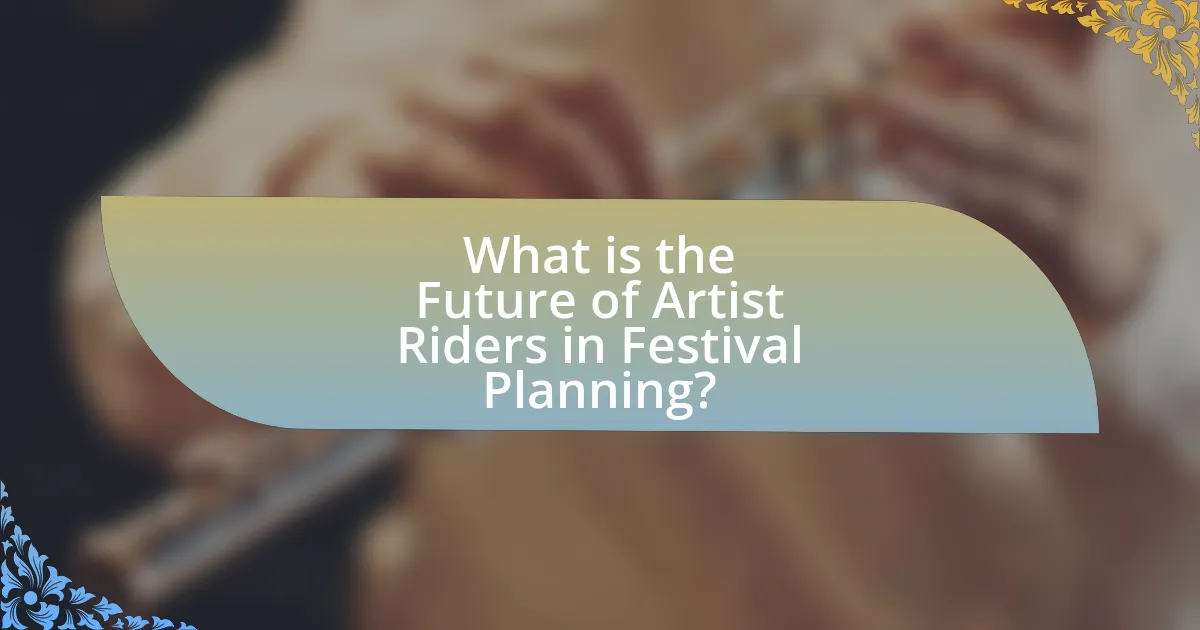
What is the Future of Artist Riders in Festival Planning?
The future of artist riders in festival planning is increasingly focused on customization and sustainability. As festivals evolve, artists are demanding more personalized experiences that reflect their brand and values, leading to more detailed and specific rider requests. This trend is supported by the growing emphasis on sustainability in the music industry, prompting artists to include eco-friendly requirements in their riders, such as sustainable catering options and waste reduction practices. Additionally, advancements in technology are facilitating better communication between artists and festival organizers, allowing for real-time adjustments to rider specifications. This shift towards tailored and responsible planning is expected to enhance artist satisfaction and audience engagement at festivals.
How are trends in the music industry shaping Artist Riders?
Trends in the music industry are significantly shaping Artist Riders by increasing demands for personalization and sustainability. As artists gain more control over their branding and public image, they are requesting specific items that reflect their personal tastes and values, such as organic food options and eco-friendly products. Additionally, the rise of social media has led to a greater emphasis on unique experiences, prompting artists to include more elaborate hospitality requests that enhance their public persona. For instance, a survey by Pollstar in 2022 indicated that 70% of artists now prioritize rider requests that align with their environmental commitments, showcasing a shift towards sustainability in the industry.
What emerging practices are being adopted by artists and organizers?
Artists and organizers are increasingly adopting practices such as collaborative programming, sustainability initiatives, and digital engagement strategies. Collaborative programming involves artists working together across disciplines to create interdisciplinary projects, enhancing audience experience and fostering community connections. Sustainability initiatives focus on reducing environmental impact through eco-friendly materials and practices, reflecting a growing awareness of climate change within the arts sector. Digital engagement strategies include utilizing social media and virtual platforms to reach wider audiences, especially in response to the COVID-19 pandemic, which has accelerated the shift towards online content and remote participation in events. These practices are reshaping how festivals and events are planned and executed, aligning with contemporary societal values and technological advancements.
How might sustainability concerns influence future Artist Riders?
Sustainability concerns are likely to lead to more environmentally conscious stipulations in future Artist Riders. As artists increasingly prioritize eco-friendly practices, their riders may include requests for sustainable transportation options, biodegradable materials, and reduced waste initiatives. For instance, a survey by the Music Industry Research Association found that 70% of artists are willing to incorporate sustainability into their performance logistics, indicating a significant shift towards greener practices in the industry. This trend will influence festival planners to adapt their operations to meet these evolving demands, ultimately fostering a more sustainable event culture.
What Practical Tips Can Festival Organizers Implement Regarding Artist Riders?
Festival organizers can implement clear communication and thorough planning regarding artist riders to ensure smooth operations. Establishing a detailed checklist that includes all rider requirements, such as technical specifications, hospitality needs, and travel arrangements, helps prevent misunderstandings. Additionally, maintaining open lines of communication with artists and their management teams allows for timely updates and adjustments, fostering a collaborative environment. Research indicates that effective communication can reduce logistical errors by up to 30%, enhancing overall festival success.
How can organizers ensure they meet the needs of artists while staying within budget?
Organizers can ensure they meet the needs of artists while staying within budget by prioritizing clear communication and thorough planning. Establishing open dialogue with artists about their specific requirements allows organizers to identify essential needs versus non-essential wants. By creating a detailed budget that allocates funds based on these prioritized needs, organizers can effectively manage costs. For instance, a study by the National Endowment for the Arts highlights that successful event planning often hinges on understanding artist expectations and aligning them with available resources. This approach not only fosters a positive relationship with artists but also enhances the overall quality of the event within financial constraints.
What resources are available for organizers to better understand Artist Riders?
Organizers can access several resources to better understand Artist Riders, including industry guides, workshops, and online platforms. Industry guides, such as the “Rider Handbook” published by the Event Safety Alliance, provide detailed insights into standard rider components and best practices. Workshops hosted by organizations like the International Live Events Association (ILEA) offer practical training on rider negotiation and management. Additionally, online platforms like the “Rider Database” allow organizers to review and compare riders from various artists, enhancing their understanding of specific requirements and expectations. These resources collectively equip organizers with the knowledge needed to effectively manage artist riders in festival planning.
